These are some of my favorite DIY Christmas ornaments that I’ve made – there are full step by step instructions for all of them.
Art Copyright, Explained
Copyright law is complex, totemic, and the source of nearly unending litigation. With relative regularity, appropriation artists like Jeff Koons or Richard Prince end up in the headlines due to allegations of improper use of their source material. For artists and those working with the images of artwork, it is crucial to understand what powers are—and are not—granted by the copyright. So below, we’ve compiled brief overview of the topic.
The rights around artwork are much less straightforward than one would assume. When it comes to the specific subset of visual works governed by the Visual Artist Rights Act of 1990 (VARA), artists retain certain powers of attribution and disavowal long after the ownership of the actual tangible work of art is in the possession of a collector or institution. As I’ve previously written, VARA affords rights in addition to those afforded by copyright law. While disavowing an artwork through VARA can impact the monetary value of the piece, copyright is much more directly tied to ensuring the economic interest of the artist. Generally speaking, the more “original” a piece is, the stronger the copyright protections.
So what rights are granted to an artist when it comes to copyright? And how can they affect those in possession of a physical work of art? Look no further than Section 106, Copyright Act of 1976, as amended, codified in Title 17 of the U.S. Code. For those in too much of a hurry, I’ll summarize: Copyright gives artists who have created fixed, tangible works a bundle of rights in those works. The rights provide both artistic protection and ensure that artists can profit from what they’ve made. After an artist creates a piece, they have the right to make copies of their work, distribute those copies, perform or display the work publicly, or make works that derive from the original.
Not all of those rights transfer to the collector who goes on to purchase the piece. While many collectors assume that a work’s copyright is transferred when they purchase a painting or a sculpture, that is not the case. Copyright only transfers to the piece’s new owner if its artist evidences that it is his or her intent to transfer it. What does this mean in practice? If you buy a Jeff Koons Balloon Dog, you then have the right to display your specific copy of Balloon Dog. But, unless you’ve received explicit permission from the artist, you do not have the legal right to take pictures of the piece, make postcards, and sell them.
Rights limited and fair use
The rights afforded by copyright aren’t infinite, however. There are limitations such that the provisions don’t stifle creativity in the name of protecting it. Many of the rights enshrined in copyright are tied to the physical work. But the statute doesn’t extend to more intangible aspects of a work of art. One cannot copyright ideas, procedures, methods, or concepts, unless they’re written down and recorded. Moreover, the written accoutrement (titles, names, phrases, and slogans) are not subject to copyright.
This is a good thing, otherwise calling your work Untitled would be a violation of copyright. Also not protected are works that change, like freestyle spoken word, or pieces of information that are universally available facts, like calendar dates. Copyright of a type of an art form that is inherently intangible—like a performance—applies to notations of the choreography or documentation of the event, but not to the event or performance itself.
Then there is Section 107 of the Copyright Act of 1976. Known as fair use, the provision provides a legal defense to copyright infringement. Put simply, that means that I admit I’ve taken work from other people, but I can argue that my use of that work still deserves protection. In the case of an artist’s image being taken without permission, its acceptance under fair use is contingent on four factors. All four inform a judge who makes the final determination of the fair use argument’s validity.
This means that there is always a degree of uncertainty to what constitutes fair use. But the most important question is, are you using the image for commercial purposes (if so, you’ll likely be in trouble) or non-profit and educational purposes (if so, you’re more likely to be in the clear)? It also depends on the nature of how you’re using the copyrighted work. The “less original” or less creative your use, the weaker your fair use claim. Another important factor is the total amount of the copyrighted image being reproduced. The more you reproduce, the less likely you are to be protected by fair use. Judges will look at the extent to which that reproduction impacts the market and undermines the economic value of the author’s original. Lastly, if the image is being transformed or parodied, it can also be protected under fair use.
Practice appropriate appropriation
If you’re thinking about being an appropriation artist, you may need to put a lawyer on retainer because sooner or later you’re likely to find yourself in the midst of a copyright case. These are no small matter. Judicial decisions around appropriation can seriously restrict artistic practice, pitting different artistic communities against each other.
Just look at Cariou v. Prince. The dispute saw French photographer Patrick Cariou sue Richard Prince over works that used Cariou’s images of rastafarians. Prince, among other acts, modified the photos by painting a purple face over original images torn from purchased copies of Cariou’s book Yes Rasta. The first court to rule on the case in 2011 decided this didn’t amount to a significant enough modification of the original work to distinguish Prince’s pieces from Cariou’s images in the eyes of a “reasonable observer.” An appellate court disagreed, however, reversing the decision in 2013 for most of the works. The art market breathed a sigh of relief.
Then there is Jeff Koons. Two of the number of cases involving Koons illustrate the fine line between fair use appropriation and appropriation that violates copyright statutes. In the work that led to Rogers v. Koons, the artist found a postcard by Art Rogers featuring a photo of a smiling man and woman holding a litter of puppies. Koons removed the copyright label from the postcard and his assistants created a near identical sculpture called String of Puppies (1998). Rogers sued and eventually prevailed when the court found that a “reasonable observer” would see that Koons had copied the piece and that it was neither a parody nor original enough, and thus fair use didn’t come into play.
In Blanch v. Koons however, Andrea Blanch sued Koons, arguing the artist had violated the copyright of one of her photographs. Koons had seen the photo in an ad in Allure Magazine and used a portion of it in his painting entitled Niagara (2000). Koons argued that his use of the image was transformational, meaning that he had altered the intent and content of the image to a significant extent. In this case, unlike in Rogers, the court found that fair use did apply.
More broadly, fair use does generally protect an artist when he or she appropriates a copyrighted work for a collage or composited result and the balance of other circumstances is in the artist’s favor. This transformation of message is a factor in why the artist Sturtevant doesn’t violate copyright provisions despite creating works that often look nearly identical to their appropriated subject—she is probing what happens in the very process of repetition.
Whether you’re a collector, an appropriation artist, or just looking for a photo for your blog, it’s important to remember that specific circumstances do play a key role in how art copyright violation is judged. So, if you find yourself in legal hot water, consult an attorney.
40 Festive Christmas Nail Designs to Try in 2022
Prepare to “sleigh” at your holiday soirée with these easy designs.
By Dori Price and Marielle Marlys Updated: Dec 09, 2022 4:34 PM EST
Save Article

chillhouse
It’s Christmastime, the stockings are hung by the mantel with care — and by now your nails are polished to festive perfection. But if you just reached for a shade of red or green nail polish (or other traditional Christmas nail polish colors) we encourage you to try designs that are a bit more festive for the big day. We’re feeling inspired by the custom Christmas nail art that we’ve seen all over Instagram — including looks you can easily DIY as well as ornate details that you might want to have a professional execute. But what to try first?
Luckily, there are endless cute Christmas nail art options to choose from. From candy canes to glitter, ornaments to snowflakes, this list of impressive manicures has it all. And if you’re feeling like a design on every nail might be too ambitious (or just too much!), we also have some nail art ideas that include accent nails (or a “party” nail) to spice things up without being too loud. Plus, there are easier-than-ever nail stickers and decals to get a holiday mani in a flash. ‘Tis certainly the season for sparkle.
Now, without further ado, please meet the most adorable ways to paint your nails this winter. Whether you’re on the naughty or nice list this year, you’re sure to turn heads with these Christmas nail designs. Ahead are 40 Christmas nail ideas and cute Christmas nail designs to inspire you this season!
Advertisement – Continue Reading Below
Red Christmas Nail Designs

Avivaatri
Even a grinch can get behind a geometrical line design in a deep red velvet color. Classic, yet festive, it might be the mani you didn’t know you needed this holiday season.
Advertisement – Continue Reading Below
Abstract Snowflake Christmas Nails

nailsbymh
Over the red and green? Fair enough! Might we suggest a white Christmas and opt for an abstract snowflake design instead? Don’t forget to add stud embellishments for an unforgettable look.
Personalized Christmas Poster
Make a gorgeous personalized word-art poster to celebrate your family’s particular Christmas traditions and bring that warm fuzzy feeling into your home this winter. Making your poster is easy using our subway-art poster generator, and we have lots of ideas to get you started.


You can also use our poster generator to make a Christmas-themed word art poster with lyrics from your favourite Christmas carols, or taken from Christmas stories and poems. There are lots of lovely Christmas colour palettes to choose from and it’s a fun way to bring a touch of Christmas into your home!
*FREE* printable Christmas posters


DIY Christmas Ornament Crafts
Some more crafty DIY Christmas decorations projects for you to try.
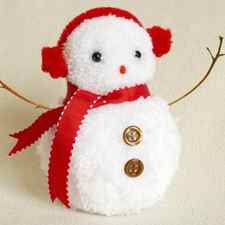
Pom Pom Snowman Craft

Sock Snowman
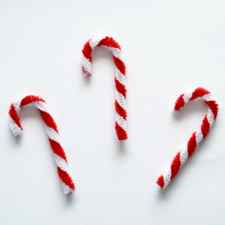
Pipe Cleaner Ornaments
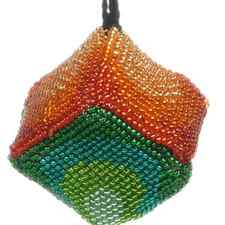
Beaded Christmas Ornaments
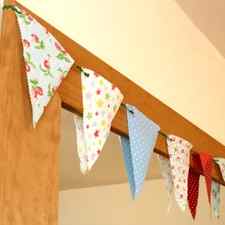
No-Sew Decorative Bunting

Miniature Christmas Tree
I think the pom pom snowmen have personality and I smile every time I see them in my living room. It’s fun re-arranging their hats, scarves and arms to give them different expressions.
Pipe cleaner ornaments are fun to make with your kids, because they’re so easy. You can get much more creative than just the candy canes – when you visit that page you’ll see that you can make animals and all sorts of other creatures too.
The beaded ornaments tutorial is something that my friend Helen wrote. I think they look beautiful, and Helen says they were pretty easy to make, but I haven’t tried making them myself.
Advent Calendars
Do Advent calendars count as homemade Christmas ornaments? In a way I think they do, because they’re something that you hang up in the house around Christmas time.
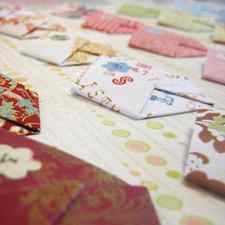
Origami Advent Calendar Pattern

Advent Calendar Wreath
The first one we made was the origami Advent calendar . A great thing about that design is how quick it is to make. There’s a simple origami fold for making the pockets that literally only takes a few seconds per pocket. And I think the final calendar turned out quite nicely.
The Advent peg wreath with chocolates all around the outside proved to be too much temptation for Tobias and I. Despite our best intentions I’m ashamed to say that all the chocolate disappeared well before the beginning of Advent. Oops. We both have a bit of a sweet tooth.





